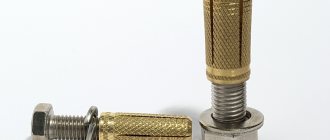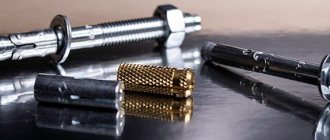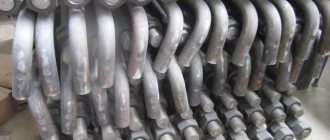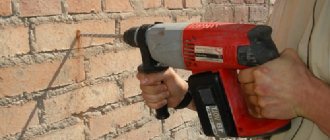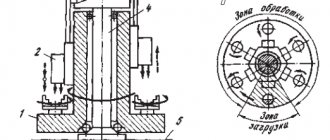The 2022 State Standard P 57787 provides a very short definition of a drive-in type anchor. The wording sounds like this: this is a hardware that must be installed in the design position by hammering its entire or component part into the base. As they say, neither add nor subtract. However, in reality everything is not so simple. In fact, the driven anchor (another common name is the collet anchor) has features of both design and application. Let's look at these questions in more detail.
Structure of a drive-in anchor
Drive-in anchors consist of a pre-assembled tubular expansion screen with an internal expansion plug.
The internal expansion plug is pressed against the bottom of the anchor using an anchor installation tool. The internal expansion plug expands the anchor in the hole and holds it in place through friction.
These anchors are made from a variety of materials, thicknesses, standards, sizes and finishes. Depending on the application or need, different types of push-in anchors are used.
Various coatings or special finishing options for plug-in anchors are actively used:
- Phosphate;
- Tin;
- Zinc (yellow, white, blue, black);
- Hot galvanizing;
- Chromium;
- Nickel-brass;
- Ferrous metal oxides;
- Powder coating.
All of these coatings result in corrosion-resistant, rust-resistant anchors.
The long-term elasticity of the alloys used ensures structural integrity, and the reduced built-in depth prevents rotation in the hole.
How to make the right choice? Tips for masters
The design of these fasteners is standard. They may differ only in material and notches (available or absent). Craftsmen usually do not have any difficulties with which anchor to choose. However, let's look at a few simple tips.
Brass products can withstand minor vertical loads. Therefore, before purchasing, you need to consult the seller and find out how much weight they can withstand. In addition, the packaging always contains the necessary information.
The steel anchor is practical and easy to use. It is galvanized, which guarantees reliable protection against corrosion. Anchors made of this material allow you to attach almost any structure.
The material of the product also affects the price. Buying brass fasteners will cost a little more than conventional steel models, as they are resistant to corrosion.
As for notches, they are present on the outer surface of anchors made of any materials. They are in contact with the walls of the hole and contribute to obtaining high-quality and durable grip.
Models without notches have a smooth surface, so they are not able to withstand heavy loads. These fasteners are used to install items that are light in weight. They are suitable for installing oversized interior parts and objects made of wood or plastic.
Scope of application of the drive-in anchor
The drive-in suspension anchor is designed for suspension anchorage in solid concrete. Commonly used for transformers, ceiling fans and electric lamps.
Drive-in anchors should only be used in hard concrete.
- Their primary purpose is to insert a threaded rod for hanging cable entries, HVAC ducts, and fire sprinkler pipes and heads.
- They can be used in applications where a flush anchor is required and where a bolt needs to be inserted and removed.
Drive-in anchors are used, among other things, for hanging pipelines, electrical conduits, pipes or sprinkler heads. Tightening tighter ensures a secure fit. The mechanism of action can be compared to a spacer pin.
Installation
Installing these mounts is a simple task, but requires care. To successfully complete the task, it is recommended to follow the scheme:
- Creating a small hole that will fit the size of the rod. For these purposes, an ordinary drill is used. The diameter of the hole should be such that the part fits in tightly;
- Cleaning the resulting opening. It is necessary to remove dirt and construction dust. For greater efficiency, you can use a vacuum cleaner or a medical bulb;
- Installing an anchor inside the opening;
- Driving the propping striker into the anchor. Can be done with a regular hammer;
If everything is done correctly, the split part of the part will expand in the walls of the opening. When the wedged anchor is properly fixed in the opening, you can screw a pin or bolt inside it and begin fastening the required object.
Load and resistance
Anchors with a diameter of 10 mm can withstand a load of approximately 250 kg (when embedded in concrete). The described mounting devices are often used in the repair or maintenance of buildings.
In such objects, the concrete is usually already loose and crumbling - this is especially true for old buildings.
- Despite this, you can safely use anchors that will tightly fill the entire surface of the opening.
- It is thanks to this that the structure will gain stability.
- Drive-in anchors can be embedded in a variety of materials, depending on the characteristics of the specific project.
- Nothing prevents them from being mounted in plastic, for example, PVC, which is especially important when finishing concrete structures.
They are also recommended for materials such as plasterboard, hollow blocks, perforated brick. Of course, nothing prevents you from using them with solid bricks and aerated concrete.
Chemical
Chemical anchors are a type of fastening elements that, in addition to frictional force and material resistance, also use adhesive force through the use of synthetic resins.
This provides additional fixation. Chemical fasteners are used when securing particularly heavy structures or when working with porous and soft materials.
Expert opinion
Torsunov Pavel Maksimovich
The chemical anchor is usually a standard stud. After drilling the hole, its walls are blown out and covered with adhesive, after which the anchor is inserted. The disadvantage of chemical anchors is that they cannot be used immediately; you must wait until the adhesive reaches maximum strength.
Colors and size
In many cases, the size can be quickly and easily selected thanks to the color:
- Yellow - diameter 5 mm, length 24 mm. They only work when installing small and light objects. They work with screws with a diameter of 3-4.5 mm. They can be used on thin surfaces;
- Red - diameter 6 mm, length 26 mm. Compatible with screws with a diameter of 3.5-5 mm;
- Brown - diameter 7 mm, length 30 mm. They are suitable for screws with a diameter of 4-6 mm;
- Blue - their average size is 8 mm, length 32 mm. In this case, self-tapping screws with a diameter of 4.5-6 mm are suitable;
- Gray - diameter 10 mm, length 36 mm. Suitable for dowels with a diameter of 5-8 mm.
How to properly secure a stud in concrete?
We are surrounded by hundreds of different materials, which from time to time have to be combined with each other. It is especially difficult to produce with those whose physical characteristics are completely different. In this article we will consider how to fix wood to concrete, in addition, we will touch on other materials. Any family expert will prove that most often during repair or construction it is necessary to combine timber and concrete. For example, to the foundation of a house when constructing a wooden building or when installing joists for a future floor, as well as performing work on cladding walls and ceilings. Everywhere we have to resolve one and the same problem - how to more reliably attach wood to concrete. How to attach timber to a foundation
Driven Anchor Materials
Driving anchors are made from various materials. If only metal is used for concrete and exterior work, then options are possible for interior spaces. The type of materials used directly affects the parameters of the mounting hardware discussed.
Steel anchors
They are designed for installation in heavy building materials, such as brick, concrete, natural stone. This is a material with high fire resistance. For this reason, it can be used in public places, which must comply with certain norms and standards.
- High fire resistance is not the only advantage of metal anchors.
- They are characterized by fairly high resistance to loads and operating conditions.
- With a carbon steel shank they have an above average service life.
Fast installation anchors guarantee a much larger pressure area. All thanks to their unique structure. As a result, the element is attached more tightly and fits more tightly to the ground.
Plastic anchors
They are called butterflies. They work well when assembling lightweight objects. They are mainly intended for empty surfaces, that is, thermoblocks. Such driven anchors cannot be subjected to heavy loads.
Anchors with polyethylene sleeve
Most often they consist of a hardened screw, as well as a polyethylene sleeve with a collar. Suitable for installation in aerated concrete, natural stone, brick or standard concrete.
Anchors made of polypropylene or nylon
Their parameters make them ideal for hard materials. Such anchors are characterized by high resistance to loads or mechanical damage. They provide high strength as well as a reliable and durable connection.
Polypropylene drive-in anchors are also available in a quick-install version, usually with a tapered flange.
- Nylon anchors, used in a variety of materials (concrete, solid and perforated masonry, drywall), consist of a sleeve with flared sections connected to a steel screw.
- In approved systems, each dowel is associated with a special screw to ensure maximum fastening strength.
- In solid supports, load transfer occurs due to friction between the expansion sleeve and the walls of the base material due to the tightening of the screw inside the sleeve; in the case of empty supports, load transfer occurs partly due to friction and partly due to expansion of the anchor in the voids of the support material.
Because the capacity of nylon plugs is determined by the friction between the flaring sleeve and the walls of the material, it is related to the design characteristics of the plug, which is the reason each product has different strengths.
Popular manufacturers
If you have already become familiar with the characteristics, design and types of drive-in anchors, it’s time to start thinking about a specific choice.
Anchors are produced by a lot of companies around the world, but it is important not to get confused in all this variety of products and choose the best quality.
Experienced buyers and experts in this field highlight the following list of leading companies from which you can safely purchase different types of drive-in anchors without worrying about quality and durability:
- German manufacturers Fischer. Everyone has probably heard about the famous German quality. The production of anchors is no exception. The above-mentioned company is the absolute leader in the market for these materials. The company has well-established logistics and delivery anywhere in the world. The only drawback is the high price for the CIS, but it is justified by the incredible quality.
- Mungo. A Swiss company that is also famous for its quality. Unfortunately, the company focuses on the production of other materials, so the circulation of drive-in anchors is very limited.
- Koelner. The European company producing this material is the closest to Russia. The quality of the product is also excellent, but the pricing policy is also quite affordable. This is the most acceptable option for ordinary builders or for basic repairs.
Photo of a drive-in anchor
In land management
Anchor products made of plastic have found application in land management and are used to strengthen banks, construct road embankments and pipelines.
Fastening elements have increased impact resistance and frost resistance, and are able to withstand the effects of groundwater, hazardous chemicals and corrosion.
Plastic fasteners are T-shaped and range from 60 to 120 centimeters in length. When driving into the ground and installing the ATP clip, the fastening elements are connected by a polymer cable and form a three-dimensional geogrid.
